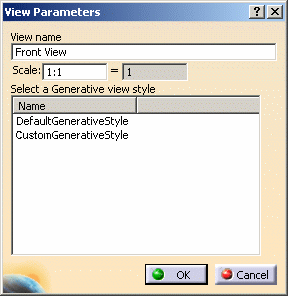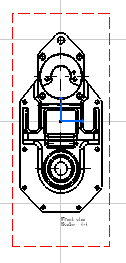For the purpose of this scenario, you will create a front view using generative view styles, but you can use generative view styles to create any type of view.
-
Go to Tools > Options > Mechanical Design > Drafting > Administration tab, and clear the Prevent generative view style usage check box. This activates the generative view style functionalities.
-
Click Front View
 in the Views toolbar. The Generative view style
toolbar is automatically displayed.
in the Views toolbar. The Generative view style
toolbar is automatically displayed. -
Select one of the generative view styles available from the list. For example, select DefaultGenerativeStyle. The parameters defined in this file will be used when creating the view.

- The generative view styles available in the list refer to the external files that can be found in specific directories as explained in Administering Generative View Styles and Standards as well as the generative view style files embedded in the drawing, but in case those files have the same name, only the embedded file is taken into account.
- The Generative view style toolbar is displayed when
creating most view types. However, when creating advanced front
views, this toolbar is not displayed. Instead, the View
Parameters dialog box (which is displayed when creating
advanced front views) features an additional list, which enables
you to select a generative view style.

-
In the 3D window, select a plane of the 3D part or a plane surface, to define the reference plane.
-
Click inside the sheet to generate the view.
The view is created using the selected generative view style. In our example, vivid edges are projected in black. Note that you may obtain a different result. This result depends on the parameters defined in the generative view style you selected.

![]()